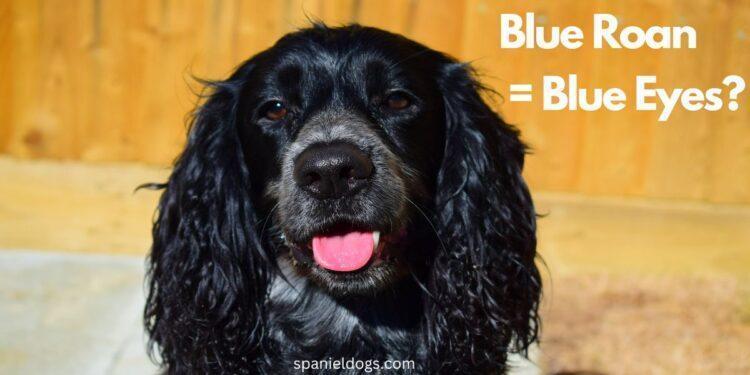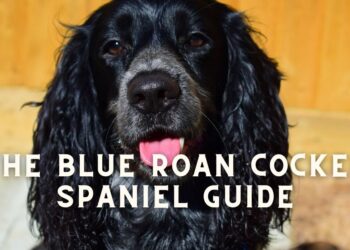Pedigree blue roan cocker spaniels do not have blue eyes. While it is true that the newly opened eyes of rowans have a bluish tint, the color stabilizes into a deep brown/ black by the time they are 14-16 weeks old. Roans in whom the blue color persists are either of a mixed pedigree or are born with heterochromia of the iris caused by melanin deficiency that gives the eyes a partially or entirely blue appearance.
Blue eyes in the Australian Shepherds, Siberian Husky, and the Alaskan Klee Kai are considered normal as these breeds carry the blue eyes variant in their genes. But in blue roan, blue eyes indicate a genetic disorder and are often accompanied by other problems of deafness and sterility. Alternatively, blue eyes in senior blue roans can signify cataract, glaucoma, or corneal dystrophy and are associated with severe vision deficit.
A Word About Blue Roans
Blue roans are Cocker Spaniels belonging to two breeds of the spaniel dog, namely the American Cocker Spaniel and the English Cocker Spaniel, with the word Cocker being imparted because of their specialization in hunting the woodcock bird.
While the species differ in fur size, temperament, and agile nature, American and English Cocker spaniel breeds both have roan color patterns ( a pattern with heavily mottled white areas), out of which the blue roan is most popular.
Blue roan cocker spaniels have originated from the English Cocker Spaniel and share the ECS characteristics of heavy fur with an energetic spirit. Technically they are not blue but get their name from the bluish hue created by the layer of black and white fur combined with a layer of white.
Blue roan cocker spaniels do not have blue eyes. They are often confused with blue-eyed Merle Cocker Spaniels because of similarities in coat colors though they are entirely different breeds.
Blue Roans, Merle Cocker and Blue Eyes
Merles are a breed of cocker spaniels with an unusual coat of black and gray hairs resulting from the merle gene mutation. Merle cocker spaniels are identified through their mottled gray fur coat with accompanying features like blue or odd-colored eyes and sometimes mottled skin pigment. Merle genes are not just found in cocker spaniels. Other breeds, like Dachshunds and Great Danes, have them as well.
The unique merle coat has been attributed to changes in the oligo length (short synthetic strands of DNA or RNA) that can again result in different coat appearances, from fully pigmented coats to those with diluted intensities.
| Cryptic | 25-55 bp |
| dilute | 66-74 bp |
| standard | 78-86 bp |
| Harlequin | 81-105 bp |
Note here bp represents base pair-it impacts the oligo length and results in the pigmentation changes.
Unfortunately, the genetic uniqueness of merle cocker spaniels also gives rise to visual and auditory defects, especially in litters produced by merle parents. Merle puppies tend to be born with cyclic neutropenia ( an immunodeficiency disorder characterized by recurrent bacterial and inflammatory complications ) that significantly decreases their life expectancy.
On an unrelated note, Harlequin merle puppies resemble piebald puppies banned in European and American countries because of their thin coats and susceptibility to skin cancer and other complications. And it’s not just potential breeders that face problems with them, as even Kennel Clubs refuse to accept them. These dogs usually have solid white coats and blue irises and are often deaf and/or blind with associated sterility. The deafness in this condition is neither dominant nor recessive but linked to a dominant gene that disrupts pigmentation and leads to deafness with other systemic complexities.
Piebald is a recessive allelle of the S gene where the dominant gene os expressed as a solid color and the recessive genes (3) are chiefly Piebald, extreme piebald and Irish spotting. these genes affect the fur coats of merles and determine the dilution of the fur pigments.
Genetic transmission of deafness in dogs with the recessive alleles of this pigment gene is less clear. Unfortunately, it is difficult to raise a puppy with vision and associated hearing problems, and breeders often euthanize them to avoid a future litter of defective puppies. Even after getting adopted, the vision and hearing deficits result in tendencies of startled biting with an accident-prone life, and many of these pups are short-lived.
The ideal way out is to carefully choose a blue roan pup instead of a merle spaniel. Some of the characteristic features of blue roans being
- Dark brown or black almond-shaped eyes in contrast to the roundish eyes of merles.
- Long low, set, flappy ears, whereas merles have moderate-long ears that are higher set than roans.
- Freckles across their legs and muzzles
- The coat color is intensely black and white with similar colored fur that solidifies with time. A merle has irregular blotches of fur set on a lighter background of the same pigment, such as solid black on gray.
- Solid black patch around the eyes, nose, and back
Conclusion
Blue roans, as a rule, are not blue-eyed. If you have fostered or adopted a blue-eyed roan, ensure that your pup stays inside the house, as blue eyes are associated with problematic vision, especially when exposed to the sun. Keeping in mind their light sensitivity, it is a good idea to enable them with shades to help in better visibility during the daytime.
If you are a dog lover then, Subscribe to our weekly newsletters. No Spams!







